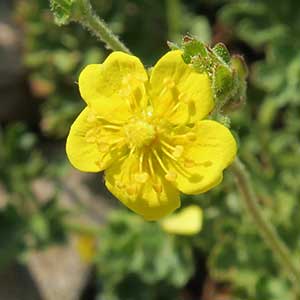Potentilla brevifolia
Potentilla pedersenii
short-leaf cinquefoil, sparse-leaf cinquefoil
not sheathed with marcescent whole leaves.
ascending to nearly erect, 0.4–2 dm.
petiole 1–4 cm, eglandular hairs absent or sparse, spreading, less than 1 mm, weak, glands abundant.
often both ternate and palmate or subpalmate on same plant, 2.5–4 cm;
petiole 1.5–2.5 cm, long hairs common to abundant, loosely appressed to ascending-spreading, 1–2 mm, weak to ± stiff, verrucose, crisped(/short) hairs absent or sparse to common, cottony hairs absent, glands sparse to common;
leaflets 3–5, proximalmost separated by 0–2 mm, central broadly elliptic to obovate, 1–1.5 × 0.5–0.9 cm, petiolules 1–2 mm, distal 2/3–3/4 of margin incised 1/2–3/4 to midvein, teeth (2–)3–4 per side, 4–6 mm, apical tufts ± 1 mm, abaxial surfaces grayish white to white, long hairs abundant (sometimes obscuring entire surface), cottony-crisped hairs abundant to dense, short hairs absent or obscured, glands sparse to common but usually obscured, adaxial grayish green to gray, long hairs sparse to abundant, 1–1.5(–2) mm, ± weak, short (short-crisped) hairs absent or sparse, rarely common, cottony hairs absent, glands absent or sparse, rarely common.
0–2.
(1–)3–7-flowered, open, branch angle 30–50°.
1–2 cm, proximal to 4 cm.
epicalyx bractlets lanceolate-elliptic to ovate, 2–4 × 0.8–2 mm;
sepals 3–5(–7) mm, apex broadly acute to obtuse;
petals 3.5–6.5 × 3–5 mm;
filaments 1–2.5 mm, anthers 0.5–0.6 mm;
carpels 10–15.
epicalyx bractlets narrowly ovate to elliptic, 4–5 × 1–1.4 mm;
hypanthium 3–4 mm diam.;
sepals 4–6 mm, apex subacute to acute, glands sparse to common, usually not obscured;
petals pale yellow, usually not overlapping, 6–7 × 4–8 mm, distinctly longer than sepals;
filaments 1–2 mm, anthers ± 0.4 mm;
carpels 40–80, styles 0.8–0.9 mm.
1–1.5 mm.
1.1–1.2 mm.
Potentilla brevifolia
Potentilla pedersenii
Potentilla brevifolia is found mainly in alpine situations in the Pioneer, Sawtooth, Smoky, and White Cloud mountains of central Idaho; the Madison Range of western Montana; the Jarbidge Range of northeastern Nevada; the Blue, Steens, and Wallowa mountains of eastern Oregon; and the Teton Range of northwestern Wyoming. The elongate caudices are easily covered by moving soil and talus.
(Discussion copyrighted by Flora of North America; reprinted with permission.)
Potentilla pedersenii and P. uschakovii account for the majority of arctic populations previously included in a broadly defined P. rubricaulis. The diagnostic morphological characters between the two species can be variable and overlapping; they are treated separately in part because of differences in presumed parental combinations. Whereas P. pulchella is the probable sect. Pensylvanicae parent for both species, the putative sect. Niveae parent for P. pedersenii is P. arenosa subsp. arenosa; that of P. uschakovii is P. subvahliana. Reflecting this parentage, P. pedersenii is distinguished by caudex branches with no marcescent whole leaves, verrucose long hairs on petioles, and inflorescences with usually several relatively small flowers. In contrast, P. uschakovii often has marcescent whole leaves sheathing the caudex branches, smooth long hairs on petioles, and one- or few-flowered inflorescences with mostly larger flowers. These generalities aside, there is much variation within both species, such that each island or population group may have its own features; it is probable that both P. pedersenii and P. uschakovii have evolved from multiple hybridization events.
(Discussion copyrighted by Flora of North America; reprinted with permission.)


